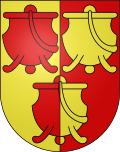Plagne BE
| BE is the abbreviation for the canton of Bern in Switzerland and is used to avoid confusion with other entries in the name Plagne . |
| Plagne (German Plentsch) |
||
|---|---|---|
| State : |
|
|
| Canton : |
|
|
| Administrative district : | Bernese Jura | |
| Residential municipality : | Suck | |
| Postal code : | 2536 | |
| former BFS no. : | 0440 | |
| Coordinates : | 588 505 / 226387 | |
| Height : | 862 m above sea level M. | |
| Area : | 7.55 km² | |
| Residents: | 361 (December 31, 2013) | |
| Population density : | 48 inhabitants per km² | |
| Website: | www.plagne.ch | |
| map | ||
|
|
||
Until December 31, 2013, Plagne was a political municipality in the Bernese Jura administrative district in the canton of Bern in Switzerland . The former German name Plentsch is still used regionally and is written Pläntsch in everyday life . On January 1, 2014, Plagne merged with the former municipality of Vauffelin to form the new municipality of Sauge .
geography
Plagne lies at 862 m above sea level. M. , seven kilometers north-northeast of Biel (linear distance ). The former farming village extends on the southeast slope of the Jura range of the Montagne de Romont, above the Synclinal valley of Vauffelin.
The area of the 7.6 km² former municipal area includes the ridge of the anticline of Plagne, which is divided from west to east into the corridors Pâturage des Esserts , Prés de Sapin and Prés de la Montagne . The highest point of Plagne is 1100 m above sea level. M. on the Montagne de Romont. On the ridge there are extensive Jura high pastures with the typical mighty spruce trees , which either stand individually or in groups, as well as numerous weekend and holiday homes scattered around. In the far west the municipality extends to the steep drop to the breakthrough valley of the Schüss ( French: Suze ) through this anticline ( Klus von Rondchâtel). In the south the area extends into the depression of the dry valley of Vauffelin, in the north into the valley of the Terbez , a left tributary of the Suze. In 1997, 5% of the municipal area was accounted for by settlements, 62% for forests and trees and 33% for agriculture.
Plagne has several individual farms. Until December 31, 2013 , neighboring communities were Péry , Vauffelin and Romont .
population
With 361 inhabitants (as of December 31, 2013), Plagne was one of the smaller communities in the Bernese Jura . 76.3% of the residents are French-speaking, 21.1% German-speaking and 0.8% Italian-speaking (as of 2000). The population of Plagne was 262 in 1850 and 292 in 1900. Since 1960 (239 inhabitants) a significant increase in population has been registered.
politics
The voting shares of the parties on the occasion of the National Council elections in 2011 were: SVP 34.2%, SP 19.2%, GPS 10.7%, BDP 9.1%, FDP 8.7%, CVP 3.3%, glp 3.1 %, EDU 2.6%, Les Rauraques 2.6%, PNOS 2.0%, SLB 2.0%, pirates 1.3%, EVP 1.1%.
economy
Plagne is still dominated by agriculture today, with cattle breeding and dairy farming predominating, there are also some fruit trees near the village . Local small businesses offer additional jobs. In the last few decades Plagne has developed into a residential community. Many of the employed people are commuters and work in the city of Biel or in the Grenchen region .
traffic
The village is away from the major thoroughfares. It can be reached by a spur road that branches off from the Frinvillier –Grenchen cantonal road. Plagne is connected to the public transport network through the Postbus course, which runs from Biel to Romont.
history
Until 1797 the village belonged to the Erguel lordship , which was subordinate to the Duchy of Basel , although the city of Biel also exerted greater influence at times. From 1797 to 1815, Plagne belonged to France and was initially part of the Mont-Terrible department , which was linked to the Haut-Rhin department in 1800 . As a result of the decision of the Congress of Vienna , the place came to the canton of Bern in the Courtelary district in 1815 . In 1851 numerous houses fell victim to a conflagration.
Until December 31, 2013, Plagne was an independent municipality .
Attractions
In the town center there are some farmhouses from the 18th century. After the village fire that raged in the upper part of the village, these houses were rebuilt in the style of late classicism . Plagne does not have its own church, it belongs to the parish of Vauffelin.
literature
- O. Keller: A dying dialect, Romont-Plagne (Bernese Jura). In: Vox Romanica , Vol. 2, 1937, pp. 394-446. ( Digitized version )
Web links
- Official website of the municipality of Plagne
- Christine Gagnebin-Diacon: Plagne. In: Historical Lexicon of Switzerland .


